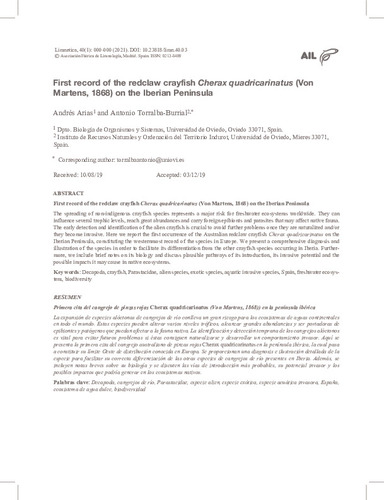First record of the redclaw crayfish Cherax quadricarinatus (Von Martens, 1868) on the Iberian Peninsula
Otros títulos:
Primera cita del cangrejo de pinzas rojas Cherax quadricarinatus (Von Martens, 1868)) en la Península Ibérica
Autor(es) y otros:
Palabra(s) clave:
Alien species
exotic species
aquatic invasive species
Invasive species
Decapoda
crayfish
Cherax quadricarinatus
Parastacidae
alien crayfish
Rivers
Asturias
Iberian Peninsula
freshwater
freshwater ecosystems
cangrejos de río
especie exótica
especie invasora
especie acuática invasora
EEI
NIS
Nora River
Río Nora
BOS Arthropod Collection
Colección de Artrópodos BOS
Fecha de publicación:
Editorial:
Asociación Ibérica de Limnología
Versión del editor:
Citación:
Descripción física:
Resumen:
The spreading of non-indigenous crayfish species represents a major risk for freshwater ecosystems worldwide. They can influence several trophic levels, reach great abundances and carry foreign epibionts and parasites that may affect native fauna. The early detection and identification of the alien crayfish is crucial to avoid further problems once they are naturalized and/or they become invasive. Here we report the first occurrence of the Australian redclaw crayfish Cherax quadricarinatus on the Iberian Peninsula, constituting the westernmost record of the species in Europe. We present a comprehensive diagnosis and illustration of the species in order to facilitate its differentiation from the other crayfish species occurring in Iberia. Furthermore, we include brief notes on its biology and discuss plausible pathways of its introduction, its invasive potential and the possible impacts it may cause in native ecosystems.
The spreading of non-indigenous crayfish species represents a major risk for freshwater ecosystems worldwide. They can influence several trophic levels, reach great abundances and carry foreign epibionts and parasites that may affect native fauna. The early detection and identification of the alien crayfish is crucial to avoid further problems once they are naturalized and/or they become invasive. Here we report the first occurrence of the Australian redclaw crayfish Cherax quadricarinatus on the Iberian Peninsula, constituting the westernmost record of the species in Europe. We present a comprehensive diagnosis and illustration of the species in order to facilitate its differentiation from the other crayfish species occurring in Iberia. Furthermore, we include brief notes on its biology and discuss plausible pathways of its introduction, its invasive potential and the possible impacts it may cause in native ecosystems.
La expansión de especies alóctonas de cangrejos de río conlleva un gran riesgo para los ecosistemas de aguas continentales en todo el mundo. Estas especies pueden alterar varios niveles tróficos, alcanzar grandes abundancias y ser portadoras de epibiontes y patógenos que puedan afectar a la fauna nativa. La identificación y detección temprana de los cangrejos alóctonos es vital para evitar futuros problemas si éstas consiguen naturalizarse y desarrollar un comportamiento invasor. Aquí se presenta la primera cita del cangrejo australiano de pinzas rojas Cherax quadricarinatus en la península ibérica, la cual pasa a constituir su límite Oeste de distribución conocida en Europa. Se proporcionan una diagnosis e ilustración detallada de la especie para facilitar su correcta diferenciación de las otras especies de cangrejos de río presentes en Iberia. Además, se incluyen notas breves sobre su biología y se discuten las vías de introducción más probables, su potencial invasor y los posibles impactos que podría generar en los ecosistemas nativos.
La expansión de especies alóctonas de cangrejos de río conlleva un gran riesgo para los ecosistemas de aguas continentales en todo el mundo. Estas especies pueden alterar varios niveles tróficos, alcanzar grandes abundancias y ser portadoras de epibiontes y patógenos que puedan afectar a la fauna nativa. La identificación y detección temprana de los cangrejos alóctonos es vital para evitar futuros problemas si éstas consiguen naturalizarse y desarrollar un comportamiento invasor. Aquí se presenta la primera cita del cangrejo australiano de pinzas rojas Cherax quadricarinatus en la península ibérica, la cual pasa a constituir su límite Oeste de distribución conocida en Europa. Se proporcionan una diagnosis e ilustración detallada de la especie para facilitar su correcta diferenciación de las otras especies de cangrejos de río presentes en Iberia. Además, se incluyen notas breves sobre su biología y se discuten las vías de introducción más probables, su potencial invasor y los posibles impactos que podría generar en los ecosistemas nativos.
ISSN:
DOI:
Patrocinado por:
Project PAPI-19-EMERG-26 (University of Oviedo)
Colecciones
- Artículos [37541]
- Biología de Organismos y Sistemas [776]
- Indurot [171]
Ficheros en el ítem




